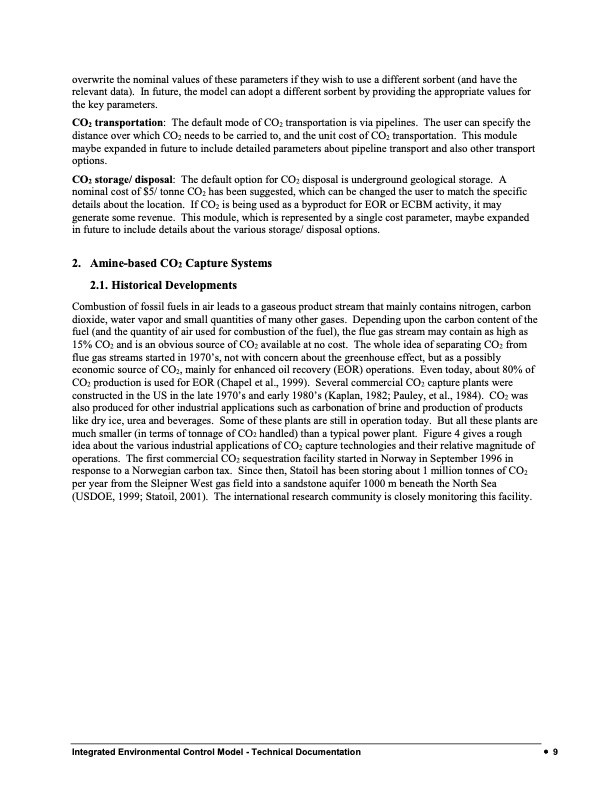
PDF Publication Title:
Text from PDF Page: 012
overwrite the nominal values of these parameters if they wish to use a different sorbent (and have the relevant data). In future, the model can adopt a different sorbent by providing the appropriate values for the key parameters. CO2 transportation: The default mode of CO2 transportation is via pipelines. The user can specify the distance over which CO2 needs to be carried to, and the unit cost of CO2 transportation. This module maybe expanded in future to include detailed parameters about pipeline transport and also other transport options. CO2 storage/ disposal: The default option for CO2 disposal is underground geological storage. A nominal cost of $5/ tonne CO2 has been suggested, which can be changed the user to match the specific details about the location. If CO2 is being used as a byproduct for EOR or ECBM activity, it may generate some revenue. This module, which is represented by a single cost parameter, maybe expanded in future to include details about the various storage/ disposal options. 2. Amine-based CO2 Capture Systems 2.1. Historical Developments Combustion of fossil fuels in air leads to a gaseous product stream that mainly contains nitrogen, carbon dioxide, water vapor and small quantities of many other gases. Depending upon the carbon content of the fuel (and the quantity of air used for combustion of the fuel), the flue gas stream may contain as high as 15% CO2 and is an obvious source of CO2 available at no cost. The whole idea of separating CO2 from flue gas streams started in 1970’s, not with concern about the greenhouse effect, but as a possibly economic source of CO2, mainly for enhanced oil recovery (EOR) operations. Even today, about 80% of CO2 production is used for EOR (Chapel et al., 1999). Several commercial CO2 capture plants were constructed in the US in the late 1970’s and early 1980’s (Kaplan, 1982; Pauley, et al., 1984). CO2 was also produced for other industrial applications such as carbonation of brine and production of products like dry ice, urea and beverages. Some of these plants are still in operation today. But all these plants are much smaller (in terms of tonnage of CO2 handled) than a typical power plant. Figure 4 gives a rough idea about the various industrial applications of CO2 capture technologies and their relative magnitude of operations. The first commercial CO2 sequestration facility started in Norway in September 1996 in response to a Norwegian carbon tax. Since then, Statoil has been storing about 1 million tonnes of CO2 per year from the Sleipner West gas field into a sandstone aquifer 1000 m beneath the North Sea (USDOE, 1999; Statoil, 2001). The international research community is closely monitoring this facility. Integrated Environmental Control Model - Technical Documentation • 9PDF Image | Amine Based CO2 Capture

PDF Search Title:
Amine Based CO2 CaptureOriginal File Name Searched:
2019Jan_IECM-Amine-based-CO2-Capture.pdfDIY PDF Search: Google It | Yahoo | Bing
NFT (Non Fungible Token): Buy our tech, design, development or system NFT and become part of our tech NFT network... More Info
IT XR Project Redstone NFT Available for Sale: NFT for high tech turbine design with one part 3D printed counter-rotating energy turbine. Be part of the future with this NFT. Can be bought and sold but only one design NFT exists. Royalties go to the developer (Infinity) to keep enhancing design and applications... More Info
Infinity Turbine IT XR Project Redstone Design: NFT for sale... NFT for high tech turbine design with one part 3D printed counter-rotating energy turbine. Includes all rights to this turbine design, including license for Fluid Handling Block I and II for the turbine assembly and housing. The NFT includes the blueprints (cad/cam), revenue streams, and all future development of the IT XR Project Redstone... More Info
Infinity Turbine ROT Radial Outflow Turbine 24 Design and Worldwide Rights: NFT for sale... NFT for the ROT 24 energy turbine. Be part of the future with this NFT. This design can be bought and sold but only one design NFT exists. You may manufacture the unit, or get the revenues from its sale from Infinity Turbine. Royalties go to the developer (Infinity) to keep enhancing design and applications... More Info
Infinity Supercritical CO2 10 Liter Extractor Design and Worldwide Rights: The Infinity Supercritical 10L CO2 extractor is for botanical oil extraction, which is rich in terpenes and can produce shelf ready full spectrum oil. With over 5 years of development, this industry leader mature extractor machine has been sold since 2015 and is part of many profitable businesses. The process can also be used for electrowinning, e-waste recycling, and lithium battery recycling, gold mining electronic wastes, precious metals. CO2 can also be used in a reverse fuel cell with nafion to make a gas-to-liquids fuel, such as methanol, ethanol and butanol or ethylene. Supercritical CO2 has also been used for treating nafion to make it more effective catalyst. This NFT is for the purchase of worldwide rights which includes the design. More Info
NFT (Non Fungible Token): Buy our tech, design, development or system NFT and become part of our tech NFT network... More Info
Infinity Turbine Products: Special for this month, any plans are $10,000 for complete Cad/Cam blueprints. License is for one build. Try before you buy a production license. May pay by Bitcoin or other Crypto. Products Page... More Info
| CONTACT TEL: 608-238-6001 Email: greg@infinityturbine.com | RSS | AMP |